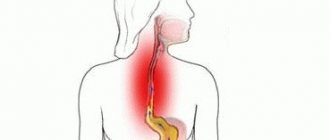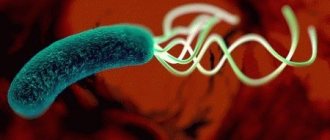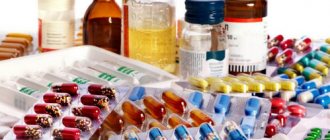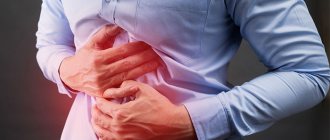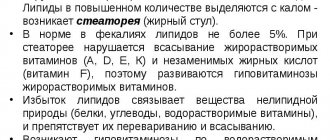In recent years, there has been a tendency for rapid growth of pathologies of the gastrointestinal tract in children; in the structure of general childhood morbidity, diseases of the digestive system are in 2nd place. Among pathologies of the digestive system, gastritis and gastroduodenitis in children account for 70 to 90% of cases, which is approximately every third child.
Most often, chronic pathology of the stomach and duodenum occurs in preschoolers and school-age children. The disease is prone to relapses, which negatively affects the anatomical and histological structure of organs, which further leads to disability, loss or decreased performance. For modern gastroenterologists, a certain concern is caused by the fact that the pathological process in the gastroduodenal zone in terms of morphogenesis and the nature of the course. In children, one can often find an atypical picture of the disease, a mild or asymptomatic course, and an increase in cases with destructive changes in the mucous membrane, including ulcerative defects.
Gastroduodenitis in children is an inflammation of the mucous membrane of the stomach and duodenum, which has a chronic course with periods of exacerbations. Peaks of incidence: 5-6 years and 10-12 years. The disease is accompanied by impaired physiological regeneration of the epithelium and motor-secretory function of the intestine and duodenum.
Causes of the disease
The causes of gastroduodenitis are usually divided into two main groups: endogenous and exogenous.
- Endogenous causes: genetic predisposition, increased acid formation, impaired mucus production, chronic diseases accompanied by hypoxia of tissues and organs, local blood flow disorders, poisoning and intoxication of the body, diseases of the hepatobiliary system.
- Exogenous causes: improper diet, poor quality food, non-compliance with diet, dry food, long intervals between meals, food poisoning and acute intestinal infections, neurogenic causes, contamination of the mucous membrane.
Among all the reasons, the main role is given to nutritional factors and emotional stress. The importance of these factors increases markedly with a hereditary predisposition to the disease. In this case, chronic gastroduodenitis is characterized by a morphological restructuring of the mucous membrane of the stomach and duodenum according to a nonspecific type.
In children it is very rare to find isolated forms of diseases: gastritis and duodenitis (in 10-15%). Psychological factors in school or family in children are often realized through vegetative-vascular dystonia, which has a significant impact on the secretion and motility of the digestive system. In addition, regenerative processes and the production of hormones of the gastrointestinal system are affected.
A decrease in local immunity is facilitated by long-term use of certain medications (non-steroidal and steroidal anti-inflammatory drugs), and nutritional allergies.
The role of bacterial infection in the development of gastroduodenitis in children is increasingly growing. Hhelicobacter pylori primarily causes inflammation of the gastric mucosa, and duodenitis occurs against its background. More often, gastroduodenitis, which is of a bacterial nature, has characteristic morphological changes: erosions on the mucous membrane of the stomach and duodenum. This is due to the fact that the intestinal mucosa is not resistant to the effects of acidic gastric juice, especially if part of its epithelium has undergone metaplasia.
Under the influence of causative factors, inflammation develops in the mucous membrane of the stomach and duodenum. The process of physiological regeneration of the mucous membrane is disrupted and it gradually atrophies. The development of the chronic form of the disease leads to constant damage to organ tissues and the accumulation of reactive oxygen species. They are mainly produced by leukocytes with a polymorphic nucleus. They infiltrate the mucosa. The antioxidant defense system is not able to cope with such an amount of active oxygen; oxidative processes constantly damage the mucous membrane. All these links in pathogenesis lead to disturbances in tone (increases) and motility of the stomach and duodenum.
Prevention
Preventive measures for duodenitis in children are almost identical to those rules that are recommended for adults. Their main difference is, perhaps, that children require more careful care and monitoring to ensure that preventive rules are followed.
So, prevention includes combining several components at once - proper nutrition, physical activity, absence of stressful situations, timely contact with a specialist at the first problems of the gastrointestinal tract.
Thus, proper nutrition should be suitable for the child, fully satisfy his needs for vitamins, minerals, fiber, protein, and carbohydrates. Therefore, you should carefully ensure that your diet includes not only fruits and vegetables in sufficient quantities, but also fermented milk products, meat, and fish.
No less necessary for harmonious and full development and the absence of duodenitis is physical activity. An active lifestyle allows intestinal motility to improve, blood circulation is normalized, which is an excellent measure against the development of any diseases of the gastrointestinal tract.
Also, if you notice that your child has an exacerbation of duodenitis, you notice the presence of pain, weakness, lack of appetite, then you should visit a specialist as soon as possible. After all, these symptoms may indicate completely different problems with digestion and well-being.
Self-medication of absolutely any plan can provoke the most unforeseen consequences. Therefore, you should not use supplies in your home medicine cabinet, or resort to using traditional untested methods, since they can very realistically lead to a worsening of the condition. If a high temperature appears or vomiting occurs, parents are strongly advised to call an ambulance for emergency first aid procedures.
Classification of the disease
There are several types of classification of gastroduodenitis.
- For reasons of occurrence:
- infectious etiology (associated with Helicobacter pylori infection, fungal and viral);
- caused by chemical factors;
- allergic nature;
- as a result of autoimmune aggression;
- special forms of the disease (granulomatous and eosinophilic);
- without an identified causative factor.
- According to the localization of inflammatory changes:
- antrum and fundus;
- pangastritis (common).
- According to morphological changes:
- according to the results of endoscopic examination: superficial, erosive, hypertrophic, subatrophic, hemorrhagic, mixed form;
- histological characteristics: superficial, gland damage without atrophic changes, atrophic, subatrophic.
- State of gastric secretion:
- increased;
- normal;
- reduced.
- Stages of the pathological process:
- exacerbation stage;
- remission;
- incomplete remission.
The division of gastroduodenitis into stages is conditional, since the disease often has mixed forms and can progress along several paths. Thanks to the conditional classification, it became possible to correctly treat the disease, according to its etiology and morphological changes.
The symptoms of gastroduodenitis are varied, which is primarily associated with the severity of structural changes in the mucosa, the localization of the process, its stages, the degree of dysfunction of the stomach and duodenum, and the state of metabolic processes in the body.
General symptoms: weakness, fatigue, sleep disturbance and headaches. The child becomes irritable and whiny. Objectively, one can notice pallor of the skin and signs of multivitamin deficiency. Sick children have severe muscle weakness. The severity of clinical symptoms depends on the degree of metabolic disorder.
Currently, such a common pathology as gastroduodenitis is described in many sources, so you can often find conflicting ideas about the clinic of one or another form of gastroduodenitis. It is more expedient to combine symptoms into specific symptom complexes, depending on the topographic characteristics of the disease, the severity of damage to the mucous membrane of organs, as well as the motor-secretory functions of the stomach and duodenum. The treatment of gastroduodenitis is based on the classification below.
Variants of the clinical picture of gastroduodenitis.
- Chronic gastroduodenitis caused by exogenous factors. The most pronounced changes in the mucosa are in the antrum of the stomach and in the duodenum: signs of inflammation, subatrophic and (or) hypertrophic signs, the presence of erosions. Nozoologically, these are duodenitis, gastroduodenitis, antral gastritis, erosive duodenitis or antral gastritis. This form of the disease has the peculiarity that acid formation and enzyme production are preserved or increased, the secretory and motor functions of the stomach and duodenum are discoordinated. The sick child exhibits symptoms: cephalgia, irritability. Appetite is usually not impaired. Typically, children develop cardiac failure, which causes dyspeptic disorders (sour belching, heartburn). Sometimes children are bothered by thirst. The disease is accompanied by pain. Intense pain in the epigastric or pyloroduodenal area. The time of their appearance is after a meal or on an empty stomach. The pain may disappear after eating. The tongue of children in this group is covered with a white coating and there is a tendency to constipation.
- If the disease has a long history, and endogenous and toxins predominate among the risk factors, then the fundus of the stomach is involved in the pathological process. Along with the changes described above (inflammatory, atrophic, subatrophic, focal atrophy), multiple erosive defects of the mucosa are observed in the middle third of the stomach. The nosological form of gastroduodenitis corresponding to these changes is: gastritis of the fundus of the stomach, gastroduodenitis involving the glandular apparatus of the stomach in the inflammatory process, erosive lesions of the mucous membrane. The peculiarity of this form of the disease is: decreased production of hydrochloric acid and enzymes, decreased tone of the digestive organs. Symptoms: Children with this type of gastroduodenitis experience rapid fatigue, weakness, and lethargy. Dyspeptic signs are expressed: belching of air; after eating, the child may complain of a feeling of heaviness and fullness in the stomach, nausea. The pain syndrome is more often expressed after eating, it is low-intensity, and the pain is dull in nature. On palpation, painful areas: the upper and middle third of the distance between the navel and the xiphoid process. Children are prone to increased gas formation and flatulence. The stool is often liquefied.
- The third type of clinical picture with gastroduodenitis is observed in children who have hereditary morphofunctional changes in the mucous membrane of the stomach and duodenum. Often these changes lead to the development of peptic ulcer disease, therefore they are considered a pre-ulcerative condition. Histological changes: hyperplastic fundic glands, an increase in the number of main and parietal cells. Possible nosological forms: gastritis, gastroduodenitis, duodenitis, combined with increased constant formation of hydrochloric acid and enzymes, severe inflammation and hyperplastic and erosive changes in the mucous membrane of the stomach and duodenum.
The symptoms are almost no different from those of a peptic ulcer. The main symptom is “hunger” pain. The time of their appearance is before meals or 2-3 hours after meals. The pain is strong, intense, stabbing, paroxysmal, cutting. Typical localization is the pyloroduodenal zone and left hypochondrium. Children are also worried about dyspeptic symptoms: sour belching and heartburn. The seasonality of gastroduodenitis is clearly visible - spring-autumn, in about half of the patients. The stool changes towards constipation. Positive Mendelian symptom (pain in the pyloroduodenal area during percussion).
Symptoms of duodenitis in children
The acute stage of duodenitis involves pain in the right hypochondrium or closer to the center of the abdomen. The disease is characterized by paroxysmal, sharp pain. Also, the pain symptom typically appears on an empty stomach or at night, as well as 1-2 hours after the last meal. The child also exhibits symptoms such as:
- heaviness in the stomach;
- nausea;
- vomit;
- weakness;
- drowsiness;
- increased sweating;
- moodiness;
- tachycardia.
Typically, these symptoms do not last longer than 14 days. Often duodenitis is accompanied in parallel by gastritis or cholecystitis. Also, if treatment is ignored, a small patient may experience gastroduodenitis.
Diagnosing the disease solely by consulting a doctor is impossible. Based on the symptoms, the doctor can only guess the reason why the digestive system malfunctioned. That is why doctors necessarily prescribe a number of instrumental studies and some tests.
Important: The most important part of the diagnosis is the examination of other digestive organs, such as the pancreas, liver, gallbladder and others. This allows you to promptly determine the presence of concomitant problems that cause painful symptoms.
Treatment of the disease
Treatment of gastroduodenitis is complex. It involves mental and physical rest, physiotherapy and drug therapy. An important step in treating pathologies of the digestive system is diet.
Chronic gastroduodenitis in children in the acute stage requires the patient to remain in bed for 3-5 days. When dyspeptic disorders begin to subside, the regimen may be relaxed.
The diet is prescribed according to the form of the disease, taking into account acid production. Chronic gastroduodenitis with high acidity requires compliance with table No. 1a, No. 1b. diet for patients with chronic gastroduodenitis with low acidity No. 2.
The diet has general principles: fractional meals (4-5 times per day), portions should be small, consuming too hot or cold food or drinks is not allowed. The longest acceptable interval between meals is 4 hours. Dinner for children diagnosed with gastroduodenitis should be no later than 19-20 hours. The diet involves eliminating foods that lead to increased bile production. These are vegetable and animal fats, yolks, fried foods, cream, caviar, fatty dairy products and cakes. Among dairy products, preference is given to kefir, fermented baked milk, narine, and low-fat sour cream. Children with chronic diseases of the digestive system are strictly prohibited from drinking highly carbonated drinks, and especially those containing dyes. The use of chewing gum has a negative effect on the production of hydrochloric acid and enzymes. The child's diet should be based on the principles of mechanical, thermal and chemical sparing of the mucous membrane.
The doctor will prescribe drug treatment taking into account the nosological characteristics of the disease and the production of hydrochloric acid.
To block the acid-peptic factor in patients with gastroduodenitis with high acidity, antacids are prescribed. In pediatrics, it is safest to use non-absorbable antacids based on magnesium and aluminum. These are Almagel A and Almagel - a measuring spoon 3-4 times a day. The drug Phosphalugel also increases the protective properties of the mucous barrier. Drink 1-2 packets 3-4 times a day.
A good effect is achieved by combined treatment of various antacid drugs, 4-5 times a day and always at night.
Treatment with colloidal bismuth salt. The drug covers the mucous membrane, ulcers and erosions with a protective film, protecting against the aggressive effects of acidic gastric juice. Take 3 tablets a day before meals and bedtime.
To relieve pain, M-anticholinergic drugs are prescribed. Pirenzipine suppresses gastrin synthesis and increases the protective properties of gastric mucus. Prescribe 250 mcg. 3-4 times a day for 3-4 weeks.
H2 receptor blockers reduce acid and secretion production. A good representative of the group is cimetidine, dosed at 15-20 mg. per one kg. weight per day. This is a first generation drug. It is possible to achieve a good effect when using 2nd and 3rd generation drugs. These include ranitidine and famotidine. Ranitidine is prescribed at 4-5 mg. per kg. weight per day, famotidine 20 mg. twice a day. Treatment will take 1-1.5 months.
To ensure psycho-emotional calm, sedatives are added to treatment, and in difficult situations - tranquilizers. Course duration is 2-3 weeks.
Gastroduodenitis associated with Helicobacter pylori infection is treated with antibacterial drugs. Despite a detailed study of the disease, there is still no consensus on the use of double, triple or quadruple therapy. Antibacterial agents that could be called the “gold standard” have also not been identified.
Treatment of Helicobacter pylori infection is carried out using drugs:
- antibacterial series (tetracyclines, amoxicillins, clarithromycin, etc.);
- bismuth-based preparations;
- antiprotozoal group (nitazol, tinidazole, metronidazole);
- H2-histamine receptor blockers;
- proton pump blockers.
Physiotherapeutic treatment has a great effect in subatrophic and atrophic forms of the disease. The following procedures are recommended: electrophoresis, ozokerite, paraffin treatment, hydro- and inductotherapy.
Diagnostics
If you suspect a child has a digestive disorder, you should contact a pediatrician, then a gastroenterologist.
During a visual examination, the doctor will identify the following signs of the disease:
- Pale, loose skin;
- Reduced body weight;
- “Bruises” under the eyes;
- Brittle nails, hair loss;
- Yellowish coating on the tongue, teeth marks on it.
The main method for detecting pathology is fibrogastroduodenoscopy, or FGDS. This endoscopic examination will help the doctor determine the form and stage of the disease. During the procedure, the specialist takes a sample of the gastric mucosa for histological and morphological analysis.
Additional diagnostic methods:
- Blood test to detect anemia;
- Fecal analysis for helminthiasis and giardiasis;
- Coprogram for identifying dysbacteriosis;
- ELISA stool analysis, breath test, PCR diagnostics to determine the bacterium Helicobacter pylori;
- Intragastric pH-metry to study the acidity of gastric juice;
- Duodenal sounding;
- Ultrasound and x-ray of the stomach to assess its motility and evacuation function.
In addition to consulting a specialized doctor, the child may be referred to an allergist and other specialists.



